Discover the learning platform powered by collaborative learning.
A 15-minute discussion with an expert
100% tailored to your needs - with ❤️
No commitment. Free as can be.
HR and L&D teams pay a lot of attention to onboarding, since nearly one-quarter of new employees leave a job within the first 45 days. Want to know how to reduce turnover during employee onboarding? The solution might not be during onboarding, exactly: if you wait until day one to engage a new hire, you’ve already fallen behind: in 2019, 65% of employers reported hiring people who do not show up on their first day.
Preboarding is the time between signing a job offer and starting the job, and it can make or break your new-hire experience. Left unattended, 80% of workers struggle with anxiety while waiting to start a new job, a feeling that lingers after their start date and damages enthusiasm, productivity, and longevity. Even worse, second thoughts can lead to reneging on an accepted position: according to a 2019 survey, 28% of professionals have done so.
If you wait until day one to engage a new hire, you’ve already fallen behind: 65% of employers reported hiring people who do not show up on their first day.
Treated with proper care, however, preboarding stokes excitement, builds a solid company/employee relationship, and prepares incoming employees to thrive. Given its importance in teeing up an excellent first day and beyond, developing a great preboarding plan should be a priority. We'll dive into how below, or you can get the big picture in our onboarding playbook, here.

By providing your contact info, you agree to receive communications from 360Learning. You can opt-out at any time. For details, refer to our Privacy Policy.
Preboarding is the crucial period between a new hire accepting a job offer, and the day they actually start work in your organization. In many cases, this time interval can last weeks or months. And you don't want to let your new employee's enthusiasm and motivation wane in this long time.
Onboarding is chronically overlooked by hiring managers and HR teams, assuming that the job's done once the contract is signed. In fact, you still have opportunities to keep new staff engaged and excited, so that they hit the ground running on day one.
Let's look now at nine ways to the preboarding period to your advantage.
Frankly, gifts are an easy win. On top of being delightful, they’re a cue to your new hire that you’re serious about building something special with them.
Sure, a job provides a salary, a chance for career development, and maybe health benefits, but little gestures can be just as important. Salespeople understand gift baskets and handwritten holiday cards strengthen client relationships and ultimately help retain them. Your new hires are no different, especially during preboarding. While they’re waiting in anticipation to see whether they made the right decision to accept the job, your gift will scream, “Yes, you did!”
Tech giants such as Dropbox, Salesforce, and Google send elaborate welcome kits that include branded pens, notebooks, mugs, and tote bags. Alternatively, you can select more creative schwag (like slinkies, granola, enamel pins, or a potted plant) to tell a better story of your company’s identity and values.
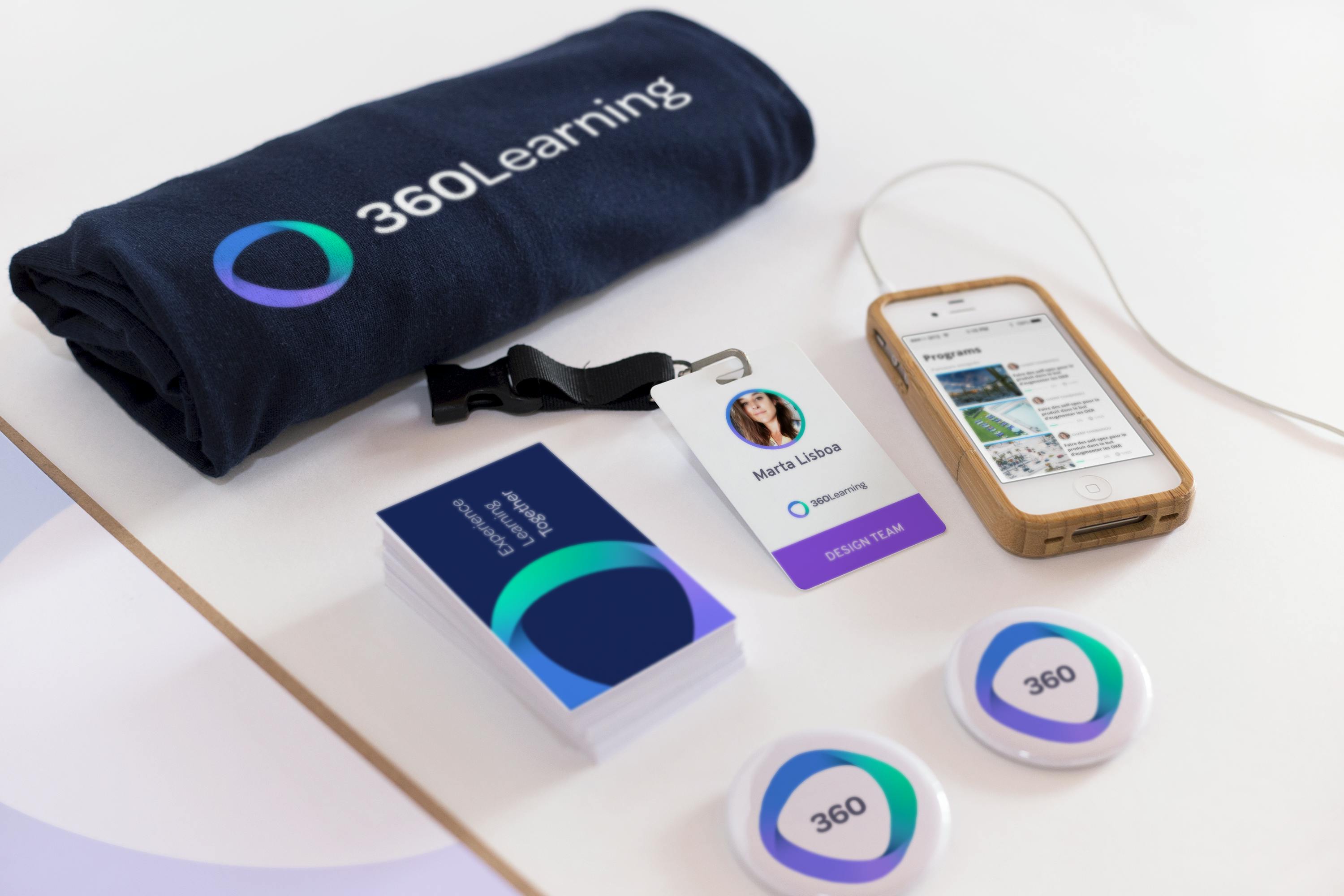
Extravagant welcome kits may not be possible for every organization, but, like birthday gifts, it’s the thought that counts.
A handwritten, personalized postcard, for example, signals—without driving up preboarding costs—that you know your new employee is worth a bit of extra effort.
You can also send a welcome email expressing your excitement about having them join the team; an introductory onboarding video from the CEO or hiring manager; or a letter from a team member, with some on-the-job anecdotes and insider tips.
Here’s a small but impactful plug-and-play email we send to each of our hires during preboarding:
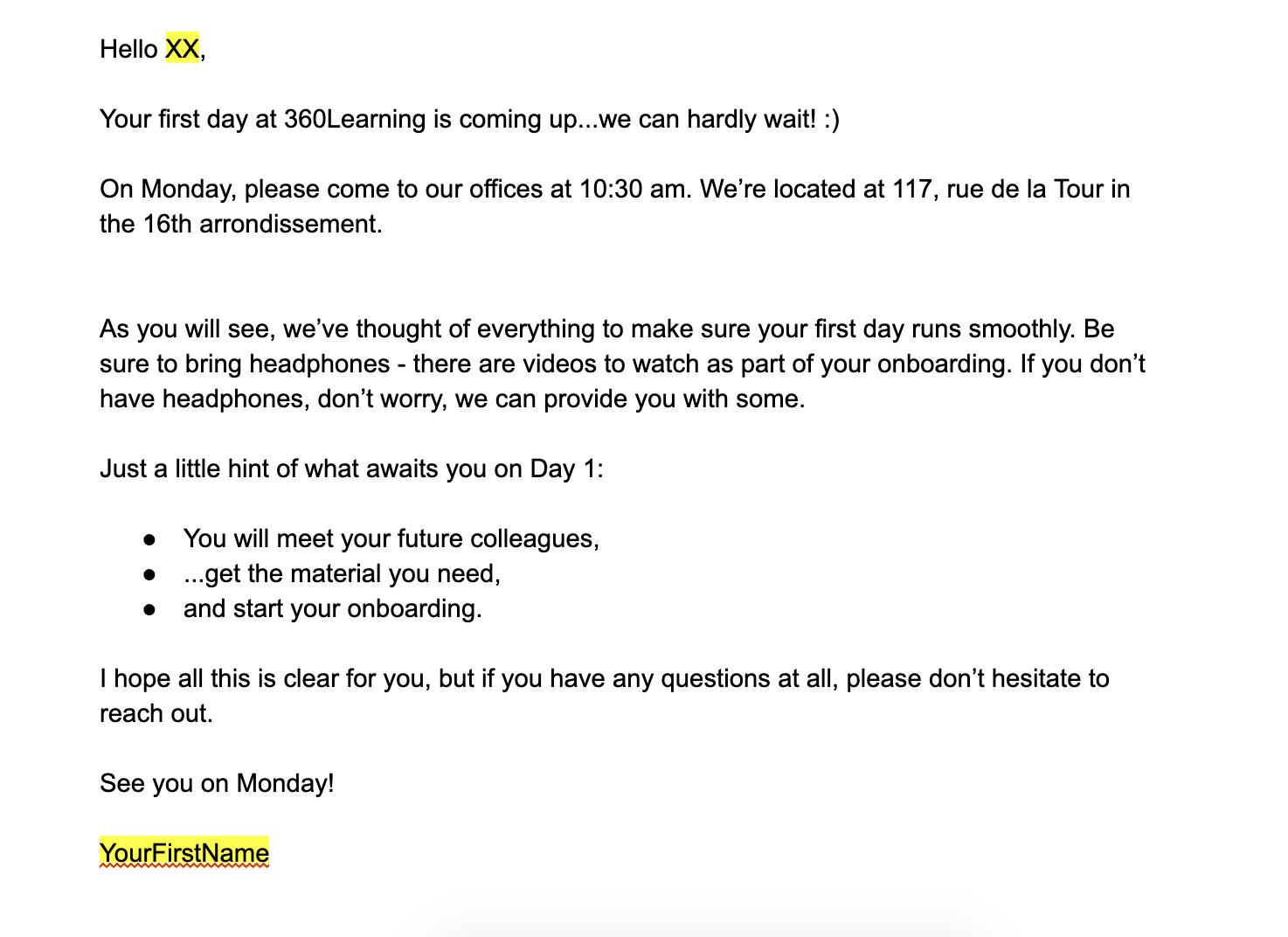
Requesting feedback about your hiring process marks the transition from candidate to team member and allows you to gather top-of-mind commentary to help you improve your hiring process.
The importance of employee empowerment can’t be overstated; it promotes productivity, creativity, and alignment of personal and company growth. And, like most elements of a positive company culture, it’s easiest to establish from the jump. By asking your new hire for feedback during preboarding, you’re priming them to feel valued and encouraging them to make an impact, and you’re establishing an ongoing line of feedback—all important strategies to boost retention.
Asking for feedback isn’t just about the new hire. There’s no better source of insight about your hiring process than a recent participant, and those insights could have a significant effect on your bottom line. In 2018, 72% of job seekers posted about a poor experience with a company during hiring, and this bad press could be deterring top talent from applying: 55% of job seekers have avoided submitting an application to a company after seeing a poor review online.
To collect feedback, create a brief candidate experience survey. A balance of close-ended questions (such as rating scale and true/false questions) and open-ended questions (which typically begin with “what,” “how,” and “why”) will give you a mix of quantitative data and nuanced personal experience to refine your recruitment strategies and hiring processes.
During preboarding, your new hire is likely crackling with nerves and excitement; don’t let it go to waste. Channel some of that fire into completing admin tasks to avoid a first day full of busywork.
Nobody wants to spend their entire first day signing forms and setting up accounts. Give your new hires the opportunity to get a head start, clearing the way for a more exciting day one. Make your expectations clear: emphasize that paperwork isn’t mandatory to complete ahead of time, but explain why they might want to get started early.
While the employees are checking items off the to-do list, most of the heavy lifting—namely, staying organized—will fall on HR. Make a single, centralized list of tasks for new hires to work through, including:
Consider organizing and communicating these tasks with a tool like Trello. For reference, this is the template I use to keep track of preboarding tasks:

Every company has different expectations. It’s your responsibility to communicate them up front, as early as possible.
The source of new-hire nerves can be unknown details. A little information can go a long way in avoiding ambiguity and first-day blunders.
“The anxiety someone can feel when starting a new job is always exacerbated by not knowing the key details,” - Jonah Goldstein, our Head of Learning
Develop a new-hire FAQ to shed light on common questions:
This is also a great opportunity to deliver resources such as an employee handbook, a benefits guide, and role-specific information to help new hires combat first-day jitters.
During the hectic first weeks of a new job, a schedule will keep everyone organized. But don’t delay: sending these invites ahead of time makes the job seem real to new hires waiting in preboarding limbo.
You can populate their calendar with training sessions, supervisor/coworker meetings, and company-wide events (like celebrations, all-hands meetings, and volunteer days) to reiterate that they’re joining an active community.
We’re strong advocates of asynchronous work, but nothing can compare with face-to-face time to build community.
An informal get-together with team members is a great opportunity for new hires to begin building relationships before their first day. Meals and happy hours are popular, but short get-to-know-you chats can also help establish early bonds. Also, don’t let the new normal get in your way—building community virtually is still possible.
Consider matching new hires with one or two of their future coworkers who are paragons of company culture. Don’t limit invites to a new hire’s direct report: nominate individuals who represent your company to act as an onboarding buddy throughout the entire onboarding process.
By the time your new hire reaches preboarding, you’ve probably told them about the company’s culture and values. Providing early access to your learning platform is your opportunity to deliver on those promises.
Learning platforms are a key part of onboarding and on-the-job training, so getting familiar with the tool ahead of time is never a bad idea. More importantly, providing access to your learning platform allows new hires to see the values of your company at work.
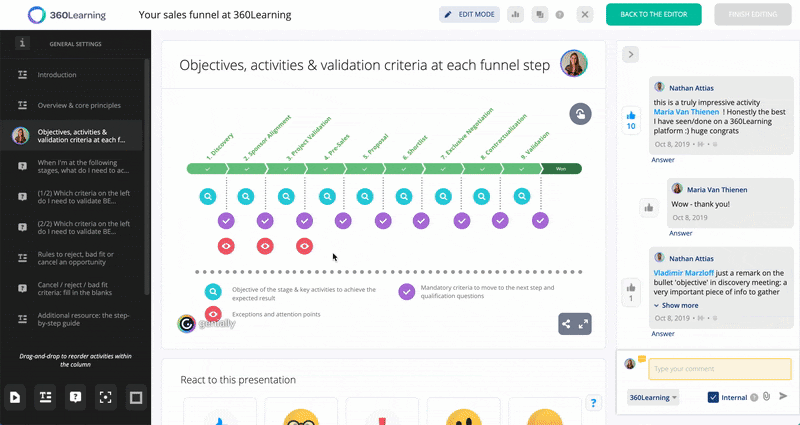
At 360Learning, for example, we live and breathe collaborative learning. Not only is it central to the product we offer, but it’s also how we get work done. For us, there’s no better way to understand our culture of learning than by observing our transparent learning platform at work.
When possible, personalization during preboarding is ideal—and that goes both ways. Empower your new hires to take control over their first impression and build community on their own terms.
While you want to give your new hire the opportunity to control their first impression, don’t paralyze them with too many options. Offer some parameters, such as filming a two-minute introduction video, creating a slideshow with photos and fun facts, or filling out a get-to-know-you quiz. Digital introductions are especially important for large or remote organizations, in which the new hire won’t be able to walk around the office and shake hands.
Here’s a great example of an employee introduction video from Wistia, a video marketing software company:
Whatever the format, the point is to encourage a new hire to craft a friendly, personal introduction for their new teammates.
During preboarding, one of your main objectives is to cultivate a sense of community. But, ultimately, it’s in your team’s hands. Therefore, the final piece of the puzzle is to get your team on the same page for a warm day-one welcome.
In the announcement, mention the new hire’s name, role, and start date, and provide their personalized intro from Step 8. If your company is large and hires at a fast pace, these announcements may get old fast, so consider including only the new hire’s direct team.
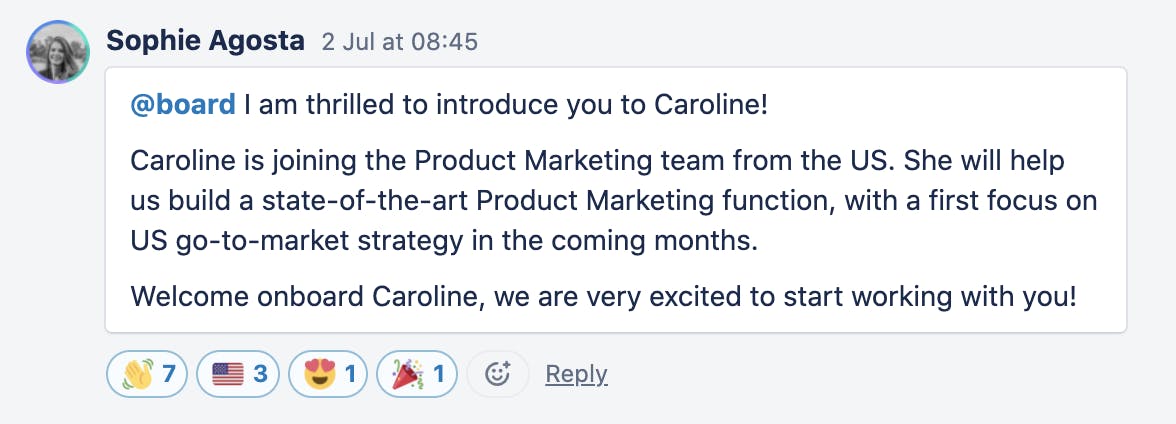
It’s best not to make the announcement too far in advance of a new hire’s arrival, to ensure it’s top of mind for your team. To go above and beyond, ask employees to reserve some time to grab a first-day (virtual) lunch or, at the very least, queue up a celebratory GIF. Your team should welcome new hires in whatever way feels genuine to your company culture; just be sure to give them some notice to prepare a warm welcome.
Like this virtual lunch we invited our new Product Marketing Director to a week before her first day:
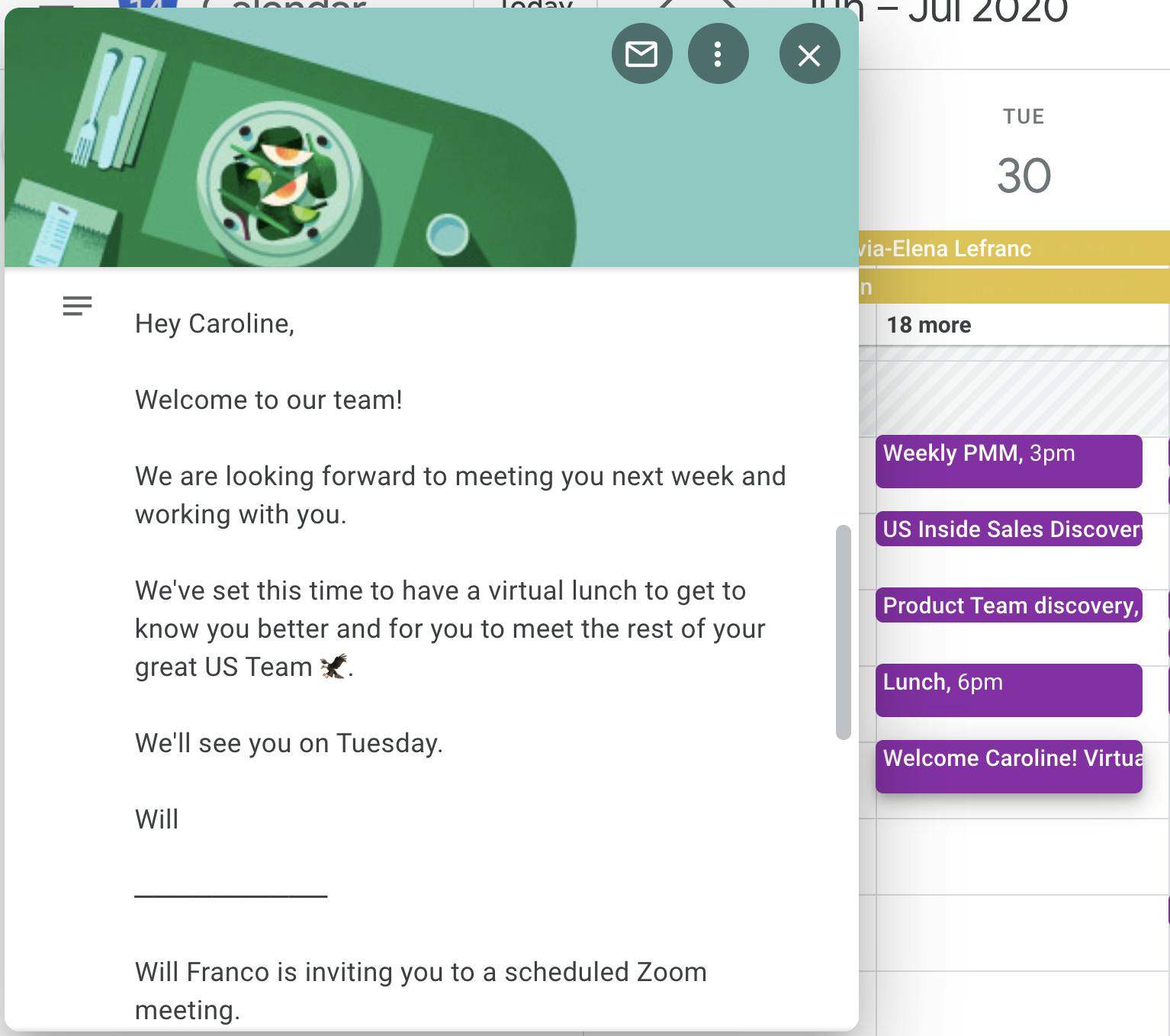
These preboarding strategies will help you reinforce employee value propositions, empower employees, and build community. But those goals don’t end on a new hire’s first day.
At 360Learning, we continually work to meet them over and over by promoting a culture of learning. This begins at preboarding, continues through onboarding, and—if we’re doing things right—remains a part of our employees’ daily routines.
In addition to these nine strategies, you can also check out our preboarding checklist to make sure you don't miss a step, or book a demo to see the 360Learning platform in action:
A 15-minute discussion with an expert
100% tailored to your needs - with ❤️
No commitment. Free as can be.
By providing your contact info, you agree to receive communications from 360Learning. You can opt-out at any time. For details, refer to our Privacy Policy.
Interested in digging even deeper? You can also learn more about how to hire and onboard employees in our recent on-demand webinar with Bryq, Strengthen your Company Culture Through Strategic Hiring and Onboarding.